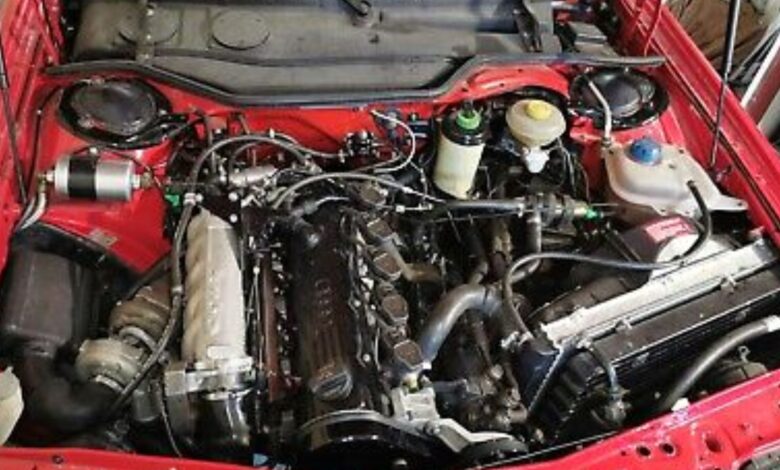Audi 5 Cylinder 10V Turbo Valve Shims Essential Knowledge for Engine Performance

Introduction
The Audi 5 Cylinder 10V Turbo Valve Shims represents a unique chapter in the brand’s performance legacy, famously showcased in models like the Audi Quattro and Audi 200 Turbo. It has captivated automotive enthusiasts and tuners for its distinctive engine note, potent power delivery, and tunability. However, like all high-performance engines, maintaining the Audi 5-cylinder 10V turbo’s efficiency requires attention to several crucial components. One such component, the valve shim, plays a pivotal role in ensuring the engine runs smoothly and efficiently.
In this comprehensive guide, we’ll explore the role of valve shims in the Audi 5-cylinder 10V turbo engine, their importance in engine performance, the symptoms of incorrect valve clearance, and how to maintain and replace them. Whether you’re a seasoned mechanic, a car enthusiast, or a novice working on your first turbocharged Audi engine, this article will give you a detailed understanding of this essential component.
What Are Valve Shims?
Audi 5 Cylinder 10V Turbo Valve Shims are small, precision-engineered discs that regulate the valve clearance between the camshaft and the tappet in overhead cam engines. The purpose of valve clearance is to allow the engine components, primarily the valves, to function properly without excessive friction or contact.
In turbocharged engines like Audi’s 5-cylinder 10V, the correct valve clearance is crucial to maintain optimal combustion, enhance engine performance, and reduce the risk of premature engine wear. Valve shims are typically made from hardened steel or another durable metal, as they must withstand high pressures and temperatures.
How Valve Shims Work
Valve shims fit into the tappet recess and work with the camshaft lobes to open and close the engine’s intake and exhaust valves at the precise moment. The gap between the camshaft and tappet must be accurate to ensure the valves open fully and close properly during each engine cycle. If the gap is too large or too small, the engine may not run efficiently, and in extreme cases, it could lead to engine damage.
The Importance of Audi 5 Cylinder 10V Turbo Valve Shims
The Audi 5-cylinder 10V turbo engine is designed for performance, and every aspect of its internal mechanics contributes to that goal. Valve shims may seem like small components, but they play a critical role in optimizing the engine’s overall performance and longevity.
1. Performance Optimization
The most immediate benefit of maintaining proper valve shim clearance is maximizing the engine’s efficiency. When the valve clearances are correctly adjusted, the engine can breathe properly, with optimal air intake and exhaust flow. This is particularly important for turbocharged engines, where the efficiency of airflow directly affects turbo performance. Inaccurate valve clearances could cause poor combustion, which in turn leads to decreased engine performance, power loss, and lower turbo response times.
2. Durability of Engine Components
The Audi 5 Cylinder 10V Turbo Valve Shims ensures that there is a small gap between the camshaft lobe and tappet, even after the engine heats up. This is important for preventing the metal components from wearing down due to excessive contact. In a turbocharged engine, which typically operates under higher stress and temperatures than naturally aspirated engines, keeping valve clearances within specifications is vital for preventing premature wear of critical components like camshafts, tappets, and valves.
3. Noise Reduction
Another function of valve shims is their role in minimizing engine noise. When the valve clearance is too large, the camshaft lobes can strike the tappets, causing a tapping or clicking noise. This noise becomes more pronounced at higher engine speeds. Correct valve clearance, ensured by proper shim adjustment, helps the engine run quietly and efficiently, maintaining smooth operation across the rev range.
Also read: 2009 Chevrolet C6500 Box Truck 13’6
Common Symptoms of Incorrect Audi 5 Cylinder 10V Turbo Valve Shims
Incorrect valve shim clearance can have several negative effects on engine performance, and recognizing these symptoms early can prevent more severe engine damage. Here are some common symptoms of incorrect valve clearance in the Audi 5-cylinder 10V turbo engine:
1. Tapping or Clicking Noise
A common symptom of incorrect valve clearance is a tapping or clicking noise, which results from excessive clearance between the camshaft lobes and tappets. This is often heard during idle or low-speed driving and may increase with engine RPM. If left unaddressed, this issue could lead to increased wear on the engine’s camshaft and tappets.
2. Loss of Power
Another sign that your valve shims might need attention is a noticeable loss of power. When the clearance between the camshaft and tappet is too tight, it can prevent the valves from fully closing. This results in a loss of compression, and the engine may not be able to deliver its optimal power output.
3. Rough Idling
If valve clearance is too wide or narrow, it can cause uneven valve operation, leading to a rough idle. This can manifest as engine misfires, which affect engine smoothness at low RPMs.
4. Increased Fuel Consumption
Incorrect Audi 5 Cylinder 10V Turbo Valve Shims can also lead to incomplete combustion. When the valves do not open and close at the correct intervals, it can cause poor air-fuel mixture combustion. This inefficiency may result in higher fuel consumption and increased emissions, further compromising engine performance.
Valve Shim Maintenance and Adjustment
Proper valve shim maintenance and adjustment are crucial for ensuring the engine runs smoothly and efficiently. In the Audi 5 Cylinder 10V Turbo Valve Shims, regular inspections are recommended, especially for high-mileage or modified engines.
Tools Required for Valve Shim Adjustment
Before you begin adjusting valve shims, you’ll need a few specialized tools to measure, remove, and replace the shims correctly. Some of the essential tools include:
- Feeler Gauges: To measure the gap between the camshaft and tappet.
- Micrometer or Caliper: For measuring the thickness of shims.
- Valve Spring Compressor: To relieve tension on the valve during shim replacement.
- Shim Removal Tool: Specifically designed for Audi engines to extract the valve shims.
- Replacement Shims: Make sure to have a variety of shim sizes available.
Valve Shim Adjustment Procedure
Here is a step-by-step process for adjusting the valve shims in the Audi 5 Cylinder 10V Turbo Valve Shims:
- Preparation Start by ensuring the engine is completely cool to prevent inaccuracies due to thermal expansion. Disconnect the battery and remove any necessary components to access the camshaft and valve train. Typically, this includes removing the valve cover, camshaft timing gear, and the timing belt or chain.
- Measuring the Valve Clearance Use the feeler gauge to measure the valve clearance for both intake and exhaust valves. Carefully insert the feeler gauge between the camshaft lobe and tappet. Take note of the clearance and compare it with the manufacturer’s specifications. The typical clearance for intake valves is around 0.10mm to 0.20mm, while for exhaust valves, it ranges from 0.20mm to 0.30mm, depending on the engine model.
- Removing the Old Shim Once the valve clearance has been measured, use the valve spring compressor to relieve pressure on the valve. After that, use the shim removal tool to carefully remove the shim from the tappet recess.
- Selecting the Correct Shim Thickness After measuring the current valve clearance and determining the required clearance, select the appropriate shim thickness to achieve the correct valve clearance. You can calculate the required shim thickness as follows:New Shim Thickness=Old Shim Thickness+(Measured Clearance−Specified Clearance)\text{New Shim Thickness} = \text{Old Shim Thickness} + (\text{Measured Clearance} – \text{Specified Clearance})New Shim Thickness=Old Shim Thickness+(Measured Clearance−Specified Clearance)Always verify the thickness of the new shim with a micrometer before installation.
- Installing the New Shim Carefully install the new shim into the tappet recess. Ensure that the shim sits flush and is properly aligned. After installation, measure the valve clearance once more to confirm it is within the recommended range.
- Reassembling the Engine Once the valve shims have been adjusted, reassemble all the engine components. This includes reinstalling the camshaft, valve cover, and other components. Torque all fasteners to the manufacturer’s specifications.

Best Practices for Valve Shim Health
Maintaining valve shims and ensuring they stay in top condition is an essential part of routine engine maintenance. Here are some best practices for maintaining the health of your Audi 5 Cylinder 10V Turbo Valve Shims:
1. Regular Inspections
Regular valve clearance inspections should be part of your engine maintenance schedule. For the Audi 5-cylinder 10V turbo, it’s advisable to inspect the valve clearance every 30,000 to 50,000 miles, depending on your driving habits and engine modifications.
2. Quality Parts and Tools
When replacing valve shims, always use high-quality OEM or equivalent parts. Investing in durable, well-made parts ensures longevity and performance. Using precision tools, such as micrometers and feeler gauges, also ensures accuracy in measurement and adjustment.
3. Monitoring Engine Performance
Pay close attention to your engine’s performance and listen for any signs of abnormal noise or power loss. If you notice any issues, perform a valve clearance check to identify potential problems before they lead to severe engine damage.
4. Keep a Maintenance Log
Keeping a record of all Audi 5 Cylinder 10V Turbo Valve Shims adjustments and replacements can be useful for tracking the long-term health of your engine. This is especially important for enthusiasts who regularly modify or tune their engines.
Tuning and Modifications Considerations
The Audi 5-cylinder 10V turbo engine is a popular choice among tuners and enthusiasts, and many choose to push the limits of its performance. Whether upgrading to a larger turbo, modifying the camshaft, or adding a higher-performance exhaust, tuning can affect the valve shim settings.
Upgrades for High-Performance Applications
- Performance Shims
When tuning for higher power, consider using performance-grade valve shims. These are specifically designed to withstand the increased stresses of high-rpm and high-torque applications. - Upgraded Valve Springs
In addition to shims, upgrading the valve springs is often necessary for high-performance applications. Stronger springs help maintain valve control under higher engine speeds and pressures. - Proper Valve Timing
For turbocharged applications, optimizing valve timing can significantly impact turbo performance. Fine-tuning valve clearance can also help with exhaust gas scavenging and improving turbo spool times.
Conclusion
Valve shims are a small but vital component in the Audi 5 Cylinder 10V Turbo Valve Shims, directly impacting its performance, efficiency, and longevity. Proper maintenance, timely adjustments, and the use of high-quality components ensure that this engine continues to perform at its best. Whether you are a professional mechanic or a passionate enthusiast, understanding and caring for the valve shims in your Audi 5-cylinder 10V turbo is essential to preserving its iconic performance and reliability.





